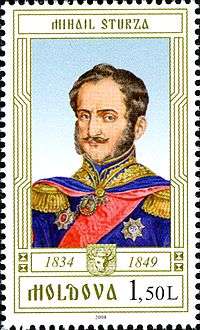Mihail Sturdza
Ion Negulici.
Mihail Sturdza (1795, Iași – 8 May 1884, Paris), sometimes anglicized as Michael Stourdza, was prince of Moldavia from 1834 to 1849. He was cousin of Roxandra Sturdza and Alexandru Sturdza.
Biography
A man of liberal education, he established in Iași, the Academia Mihăileană, an institution of higher education, and the precursor of the University of Iași. He brought scholars from foreign countries to act as teachers, and gave a very powerful stimulus to the educational development of the country.
In 1844 he decreed the emancipation of the Gypsies. Until then the Gypsies had been treated as slaves and owned by the Church or by private landowners; they had been bought and sold in the open market.
He attempted the secularization of monastic establishments, which was carried out by Prince Alexandru Ioan Cuza in 1864, and the utilization of their endowments for national purposes.
He quelled the attempted Moldavian Revolution of 1848 without bloodshed by arresting all the conspirators and expelling them from the country.
He vacationed with his family annually at Baden in Germany. When his 16-year-old son died there in 1863, he erected a Greek Orthodox church on Michaelsberg to serve as his crypt.[1]
Gallery
 Commemorative stamp
Commemorative stamp Bust of Mihail Sturdza in Baden-Baden
Bust of Mihail Sturdza in Baden-Baden The Princely Court of Moldavia during the first half of the 19th century
The Princely Court of Moldavia during the first half of the 19th century
See also
Notes
- ↑ Winch (1967), Introducing Germany, p. 75 .
References

| Preceded by Russian occupation |
Prince of Moldavia 1834–1849 |
Succeeded by Grigore Alexandru Ghica |